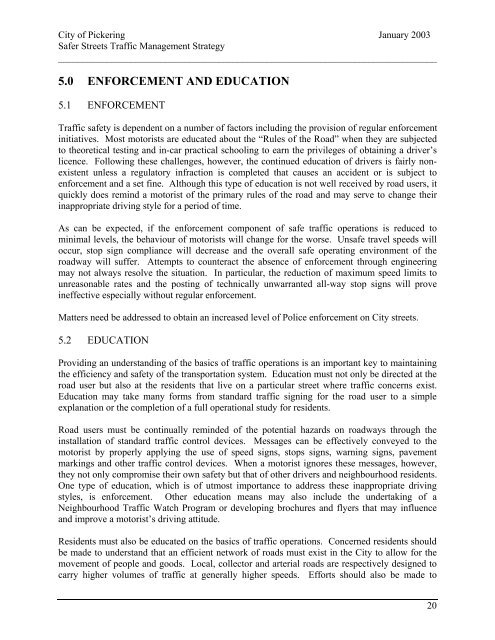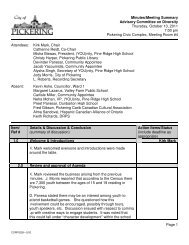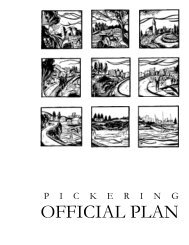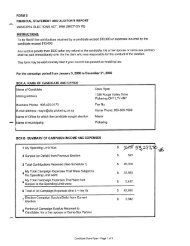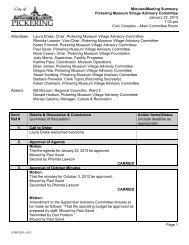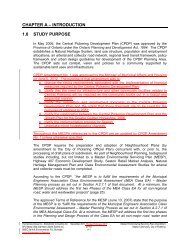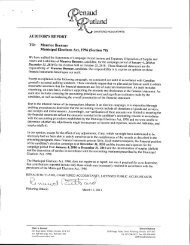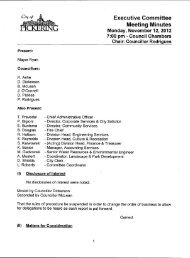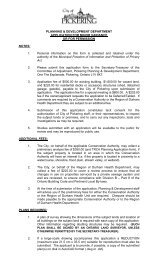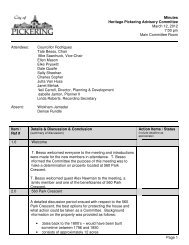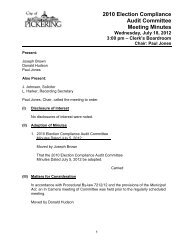foreword - City of Pickering
foreword - City of Pickering
foreword - City of Pickering
Create successful ePaper yourself
Turn your PDF publications into a flip-book with our unique Google optimized e-Paper software.
<strong>City</strong> <strong>of</strong> <strong>Pickering</strong> January 2003<br />
Safer Streets Traffic Management Strategy<br />
______________________________________________________________________________<br />
5.0 ENFORCEMENT AND EDUCATION<br />
5.1 ENFORCEMENT<br />
Traffic safety is dependent on a number <strong>of</strong> factors including the provision <strong>of</strong> regular enforcement<br />
initiatives. Most motorists are educated about the “Rules <strong>of</strong> the Road” when they are subjected<br />
to theoretical testing and in-car practical schooling to earn the privileges <strong>of</strong> obtaining a driver’s<br />
licence. Following these challenges, however, the continued education <strong>of</strong> drivers is fairly nonexistent<br />
unless a regulatory infraction is completed that causes an accident or is subject to<br />
enforcement and a set fine. Although this type <strong>of</strong> education is not well received by road users, it<br />
quickly does remind a motorist <strong>of</strong> the primary rules <strong>of</strong> the road and may serve to change their<br />
inappropriate driving style for a period <strong>of</strong> time.<br />
As can be expected, if the enforcement component <strong>of</strong> safe traffic operations is reduced to<br />
minimal levels, the behaviour <strong>of</strong> motorists will change for the worse. Unsafe travel speeds will<br />
occur, stop sign compliance will decrease and the overall safe operating environment <strong>of</strong> the<br />
roadway will suffer. Attempts to counteract the absence <strong>of</strong> enforcement through engineering<br />
may not always resolve the situation. In particular, the reduction <strong>of</strong> maximum speed limits to<br />
unreasonable rates and the posting <strong>of</strong> technically unwarranted all-way stop signs will prove<br />
ineffective especially without regular enforcement.<br />
Matters need be addressed to obtain an increased level <strong>of</strong> Police enforcement on <strong>City</strong> streets.<br />
5.2 EDUCATION<br />
Providing an understanding <strong>of</strong> the basics <strong>of</strong> traffic operations is an important key to maintaining<br />
the efficiency and safety <strong>of</strong> the transportation system. Education must not only be directed at the<br />
road user but also at the residents that live on a particular street where traffic concerns exist.<br />
Education may take many forms from standard traffic signing for the road user to a simple<br />
explanation or the completion <strong>of</strong> a full operational study for residents.<br />
Road users must be continually reminded <strong>of</strong> the potential hazards on roadways through the<br />
installation <strong>of</strong> standard traffic control devices. Messages can be effectively conveyed to the<br />
motorist by properly applying the use <strong>of</strong> speed signs, stops signs, warning signs, pavement<br />
markings and other traffic control devices. When a motorist ignores these messages, however,<br />
they not only compromise their own safety but that <strong>of</strong> other drivers and neighbourhood residents.<br />
One type <strong>of</strong> education, which is <strong>of</strong> utmost importance to address these inappropriate driving<br />
styles, is enforcement. Other education means may also include the undertaking <strong>of</strong> a<br />
Neighbourhood Traffic Watch Program or developing brochures and flyers that may influence<br />
and improve a motorist’s driving attitude.<br />
Residents must also be educated on the basics <strong>of</strong> traffic operations. Concerned residents should<br />
be made to understand that an efficient network <strong>of</strong> roads must exist in the <strong>City</strong> to allow for the<br />
movement <strong>of</strong> people and goods. Local, collector and arterial roads are respectively designed to<br />
carry higher volumes <strong>of</strong> traffic at generally higher speeds. Efforts should also be made to<br />
20


